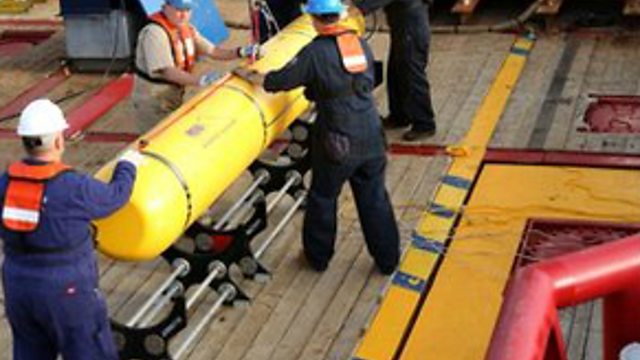
Mapping the Ocean Floor; Colorado River; Beauty and the Brain; Footballers Heat
We really do know less about the ocean floor on Earth than we do about the surface of Mars, Venus and the Moon. In the case of the Red Planet, the maps are about 250 times better.
Mapping the ocean floor
We really do know less about the ocean floor on Earth than we do about the surface of Mars, Venus and the Moon. In the case of the Red Planet, the maps are about 250 times better. This gap in our home-planet knowledge has recently been highlighted by the search for the missing Malaysia airlines plane MH370. The suspected search area in a remote part of the Indian Ocean is so poorly mapped, it's not even clear how deep the deepest parts are. Ocean floor mapping can be done by ship board echo-sounders, bouncing sound waves off the sea floor. But this is very expensive. A new cheaper, quicker way is to use a satellite to measure fluctuations in the sea surface caused by gravitational perturbations caused by underwater topography.
Colorado River
The world over, the issue of water supply is being highlighted as large dam projects threaten to limit flow down-river. The Colorado River, one of the major waterways in the United States, provides some potentially important lessons. It runs through the Grand Canyon and has the Hoover Dam on it. For the last 16 years or so, it has not reached the sea. So much water is taken out to irrigate crops or to be used for drinking by the large population in that part of the US and Mexico that there is literally nothing left. Conservationists have been campaigning for the delta of the Colorado River, in the north of Mexico, to be flooded again and that has finally just happened in a one-off experiment. Jennifer Pitt of the Environmental Defense Fund explains why getting the river to flow to the sea again is important.
White Networks
TV white spaces, the unused portions of wireless spectrum in the frequency bands used for television, are well-suited for delivering low-cost broadband access to rural and other unserved communities. Radio signals in the TV bands travel over longer distances and penetrate more obstacles than other types of radio signals requiring fewer base stations. Microsoft is unrolling a new pilot project in Ghana that aims to exploit TV whites spaces covering entire campuses at All Nations University College as part of the company’s 4Afrika Initiative. Click hears from Microsoft’s Frank McCosker and the university’s Carlene Kyeremeh.
Low Density Supersonic Decelerator
NASA's Jet Propulsion Laboratory in California is planning to test a better way of landing spacecraft. It looks like a flying saucer, and is officially known as a Low Density Supersonic Decelerator (LDSD). It was built in the same giant sterile environment where the Curiosity Rover was assembled. After the necessary precautions against dust and contaminants that could cause malfunctions in the experiment, Jack Stewart had the privilege of being shown the LDSD.
Beauty and the Brain
Dr Tiffany Jenkins asks what our brains can tell us about art. Can there ever be a recipe for beauty? Or are the great works beyond the powers of neuroscience?
She talks to Professor Semir Zeki of University College London, the first person to coin the term, neuroaesthetics, about what happens in the brain when people in a scanner see paintings or hear music.
Professor Gabi Starr at New York University tells Tiffany Jenkins why she thinks there are parts of the brain that light up when we like an art work.
Tiffany visits Christie's auction house to explore whether the best art always commands the best prices.
She also talks to Martin Kemp, Emeritus Professor of Art History at Oxford University, about our different responses to authentic paintings and to fakes.
And Tiffany discusses with art critic JJ Charlesworth why neuroscience is having an influence in some areas of art appreciation.
Footballers Heat
In some of the World Cup locations in Brazil, temperatures will reach 30 degrees Celsius with very high levels of humidity. To find out what sort of physiological challenges this is going to present for the players, consultant anaesthetist Kevin Fong took part in an experiment in an environmental chamber which replicated conditions in Brazil. As part of this he was required to run for half an hour at 30 degrees in 80% humidity. Kevin, who is the author of Extremes: Life, Death and Limits of the Human Body, joins Claudia in the Health Check studio to tell her how he got on.
Photo Credits: Getty Images
Last on
Chapters
-
Mapping the ocean floor
We know less about the ocean floor than we do about the surface of Mars and the Moon.
Duration: 09:40
Colorado River
Water supply is being highlighted as dam projects threaten to limit flow down-river.
Duration: 07:24
White networks
The unused wireless spectrum in the frequency bands delivering low-cost broadband access.
Duration: 05:53
Low Density Supersonic Decelerator
Jet Propulsion Laboratory planning to test a better way of landing spacecraft.
Duration: 06:23
Beauty and the brain
Dr Tiffany Jenkins asks what our brains can tell us about art.
Duration: 07:02
Footballers Heat
In some of the World Cup locations in Brazil, temperatures will reach 30 degrees Celsius.
Duration: 13:04
Broadcast
- Sun 1 Jun 2014 13:06GMTÃÛÑ¿´«Ã½ World Service Online
Podcast
-
![]()
Unexpected Elements
The news you know, the science you don't

